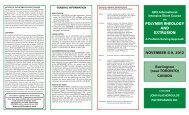The Role of Rheology in Polymer Extrusion - Polydynamics, Inc.
The Role of Rheology in Polymer Extrusion - Polydynamics, Inc.
The Role of Rheology in Polymer Extrusion - Polydynamics, Inc.
Create successful ePaper yourself
Turn your PDF publications into a flip-book with our unique Google optimized e-Paper software.
1.6 Sharksk<strong>in</strong>, Melt Fracture and Die Lip Build-Up<br />
<strong>The</strong> term sharksk<strong>in</strong> refers to the phenomenon <strong>of</strong> loss <strong>of</strong> surface gloss <strong>of</strong> an extrudate, also<br />
sometimes termed surface mattness. <strong>The</strong> surface usually exhibits a repetitious wavy or ridged<br />
pattern perpendicular to the flow direction. It occurs at a critical stress level <strong>of</strong> at least 0.14 MPa<br />
(21 psi) for most common polymers extruded through capillary dies. With some additives,<br />
lubricants, process<strong>in</strong>g aids or die coat<strong>in</strong>gs, the onset <strong>of</strong> sharksk<strong>in</strong> can be shifted to a higher shear<br />
stress level, with values up to 0.5 MPa be<strong>in</strong>g reported.<br />
<strong>The</strong> prevail<strong>in</strong>g po<strong>in</strong>t <strong>of</strong> view is that sharksk<strong>in</strong> orig<strong>in</strong>ates near the die exit and is due to<br />
stick-slip phenomena. A critical shear stress near the exit <strong>in</strong> conjunction with a critical<br />
acceleration results <strong>in</strong> sk<strong>in</strong> rupture <strong>of</strong> the extrudate [16,17]. <strong>The</strong>re was some disagreement over<br />
whether slip between the polymer and the die wall causes or helps avoid sharksk<strong>in</strong> [18].<br />
However, it is now believed that it is slip which helps to postpone sharksk<strong>in</strong> to higher flow rates.<br />
Good adherence is also thought to be potentially beneficial, but stick-slip is always detrimental.<br />
M<strong>in</strong>ute amounts <strong>of</strong> (expensive) fluorocarbon polymers are used as process<strong>in</strong>g aids with<br />
LLDPE. <strong>The</strong> proposed mechanism is that they deposit on the die surface and allow cont<strong>in</strong>uous<br />
slip. More recently boron nitride has been <strong>in</strong>troduced for the same purpose [19]. Other remedies<br />
for postpon<strong>in</strong>g the onset <strong>of</strong> sharksk<strong>in</strong> to higher throughput rates <strong>in</strong>volve reduc<strong>in</strong>g the wall shear<br />
stress by heat<strong>in</strong>g the die lips to reduce the polymer viscosity and by modify<strong>in</strong>g the die exit to<br />
<strong>in</strong>clude a small exit angle (flar<strong>in</strong>g).<br />
At higher throughput rates, extrudates usually become highly distorted and the pressure<br />
<strong>in</strong> a capillary viscometer shows significant fluctuations. This phenomenon is known as gross<br />
melt fracture.<br />
Figure 1.12 shows LLDPE extrudates for <strong>in</strong>creas<strong>in</strong>g shear rates, illustrat<strong>in</strong>g the<br />
progression from smooth surface to sharksk<strong>in</strong> and then melt fracture [20]. It is possible with<br />
some polymers to obta<strong>in</strong> melt fractured extrudates without sharksk<strong>in</strong>, i.e. the surface rema<strong>in</strong>s<br />
smooth and glossy but overall the extrudate is distorted.<br />
Proposed mechanisms for melt fracture <strong>in</strong>clude entry flow vortex <strong>in</strong>stability, elastic<br />
<strong>in</strong>stability dur<strong>in</strong>g flow <strong>in</strong> the die land for stress ratios greater than about 10 (see Equation 1.19),<br />
stick-slip phenomena and other <strong>in</strong>teractions between the polymer and the metal die wall.<br />
Probably more than one mechanism is responsible.<br />
Die lip build-up (also known as die drool) refers to the gradual formation <strong>of</strong> an <strong>in</strong>itially<br />
liquid deposit at the edge <strong>of</strong> the die exit which solidifies and grows and may partially obstruct<br />
the flow <strong>of</strong> the extruded product and/or cause defective extrudate surface. Depend<strong>in</strong>g on the<br />
severity <strong>of</strong> the problem, cont<strong>in</strong>uous extrusion must be <strong>in</strong>terrupted every few hours or days and<br />
the solid deposit removed from the die lips. <strong>The</strong> causative mechanisms are not really known.<br />
Observations suggest that the formation <strong>of</strong> die lip build-up is not cont<strong>in</strong>uous but <strong>in</strong>termittent.<br />
T<strong>in</strong>y droplets <strong>of</strong> material come out <strong>of</strong> the die or perhaps from a ruptur<strong>in</strong>g extrudate surface.<br />
Some studies suggest that the build-up is rich <strong>in</strong> lower molecular weight polymer fractions,<br />
waxes and other additives [21].<br />
19




